ARTHUM Midterm
1/40
Earn XP
Description and Tags
Pray for us
Name | Mastery | Learn | Test | Matching | Spaced |
|---|
No study sessions yet.
41 Terms
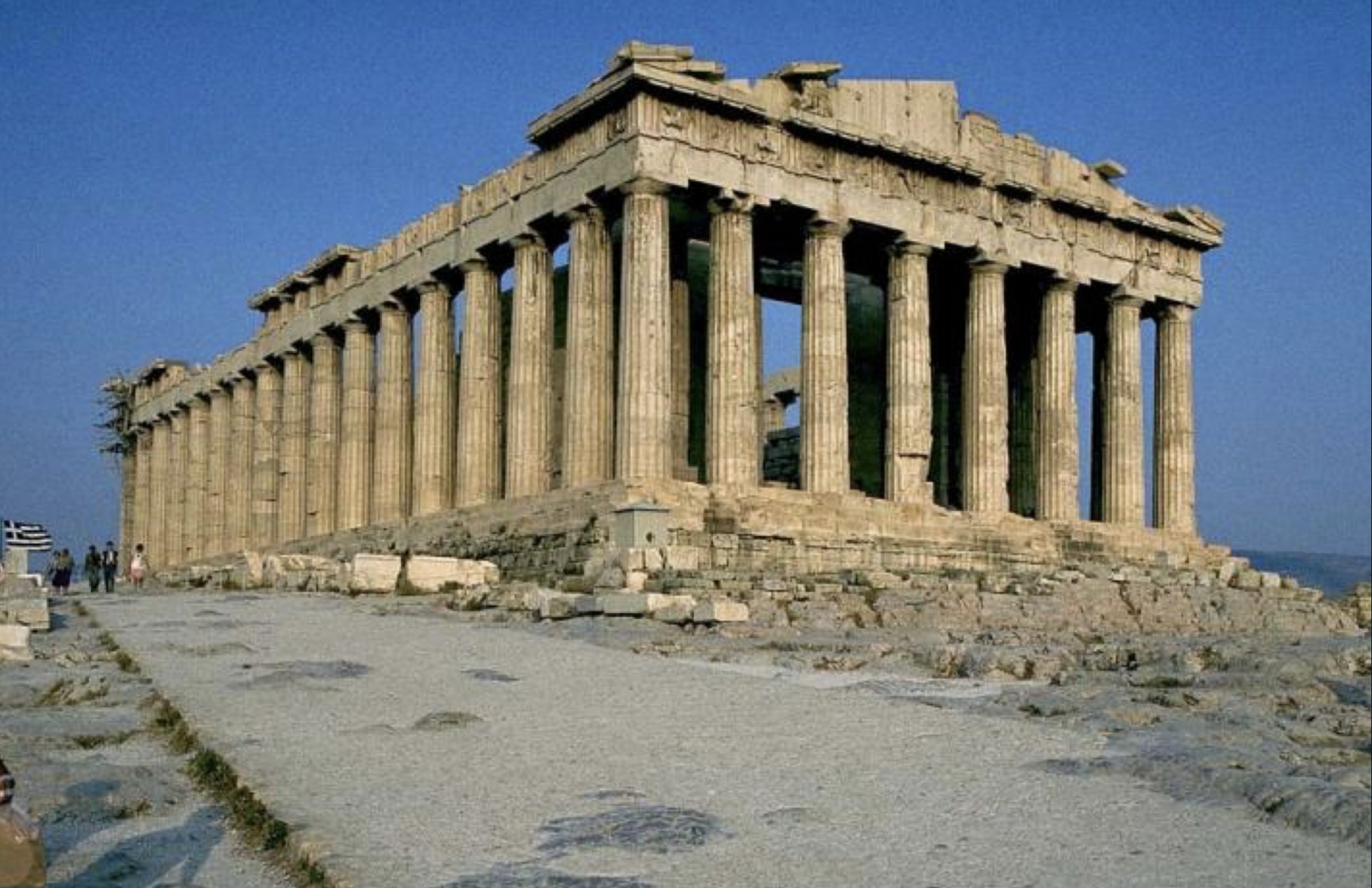
What is this?
Name of Work: Parthenon
Medium: Pentelic Marble
Subject Matter: Parthenon
Artist: Under the leadership of Pericles, Phidias oversaw the creation of the sculptures.
Date of Making: 447-432 BC
Art Historical Significance: Uses both the Doric Order(sturdy, fluted columns) and Ionic features(the continuous frieze). The metopes and frieze showcased amazing story telling and it also housed many sculptures, the most notable is the Statue of Athena.
Relevant Historical/Religious Background: Created at the height of Athen’s power. Symbolizes Democracy and Athen’s cultural supremacy.
Important Compositional Characterisitics/How it is made: Post-and-Lintel System, i.e. the ventricle posts(columns) support the horizontal lintels(entableture). Uses optical illusions to achieve symmetry and straightness. Two large pediments(east and west) that housed dynamic, three-dimensional statues(birth of athena and athena vs poseidon, respectively).
Diachronic
How art changes over time.
Synchronic
The significance of the Art at that specific time.
Contrapposto
Originated in Ancient Greek. A term used to describe a human figure in a natural post with most of their weight concentrated on one leg, suggesting relaxation and makes it look more natural.
Describe the Floor Plan of a Cathedral
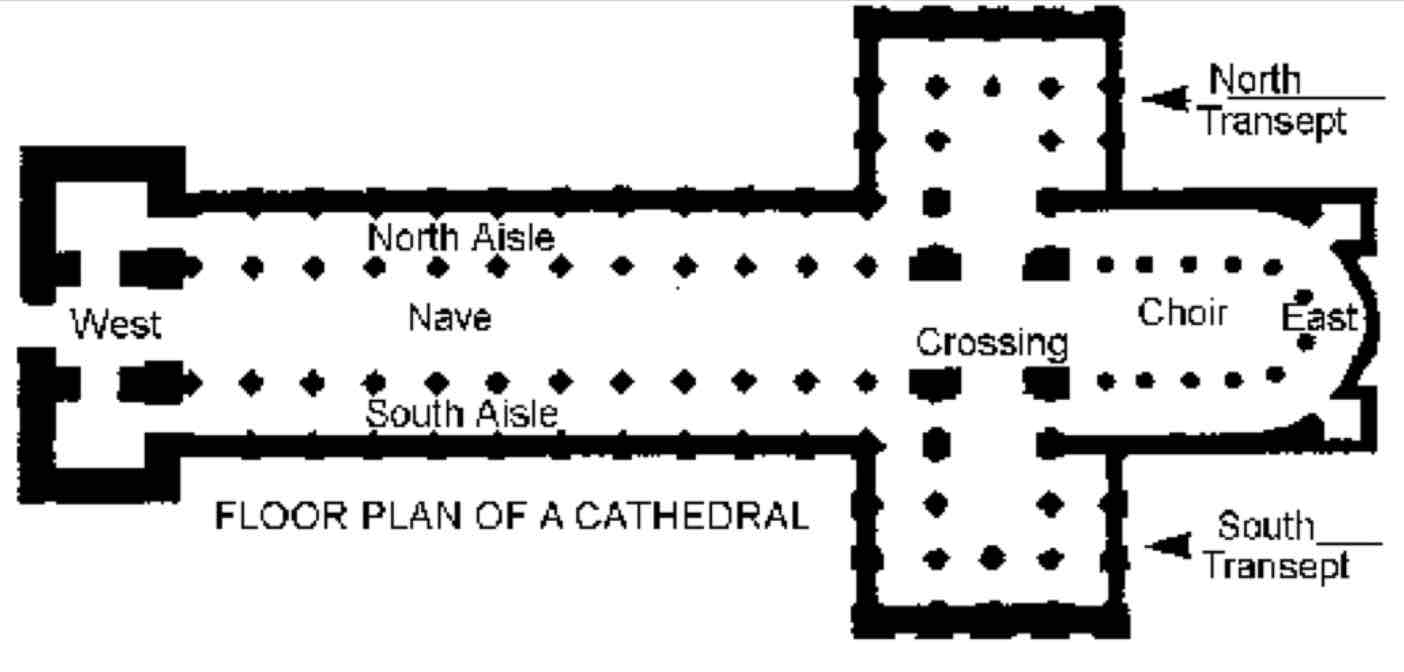
What was the main disadvantage of the post-and-lintel system?
It is unable to span large distances without requiring multiple columns or support. The significant vertical load on the supporting columns meant that the columns themselves had to be very strong and numerous, making the structure bulky and more enclosed.
What changed from the post-and-lintel system and the Roman barrel vaults? What was a disadvantage of the Roman barrel vaults?
The main difference was the implementation of an arch that allowed the distribution of weight to be more effectively across the structure. This allowed for taller more stable buildings. One main disadvantage was the horizontal forces created by the arch that required thick walls to counteract. This reduced the possibility of having large windows or opening, therefore reducing the amount of natural light inside the building.
What architectural innovations became the backbone of Gothic Structures? Why are they so important?
Ribbed Vaults and Pointed Arches:
Ribbed Vaults: Improved structural stability by channeling the forces more efficiently to specific areas, reducing the need for thick continuous walls.
Pointed Arches: Reduced the horizontal thrust exerted by the vault. This meant more of the force was directed downward rather than outwards, leading to taller structures and thinner supporting walls. Allowed for the inclusion of larger windows/openings.
Flying Buttresses:
A support structure that consists of an arch extending form the upper portion of a building to a detached pier some distance always.
Its primary purpose was to counteract the lateral forces exerted by the vaulted ceilings and pointed arches. Redirected the weight away from the buildings walls.
Name the three levels of a cathedrals.
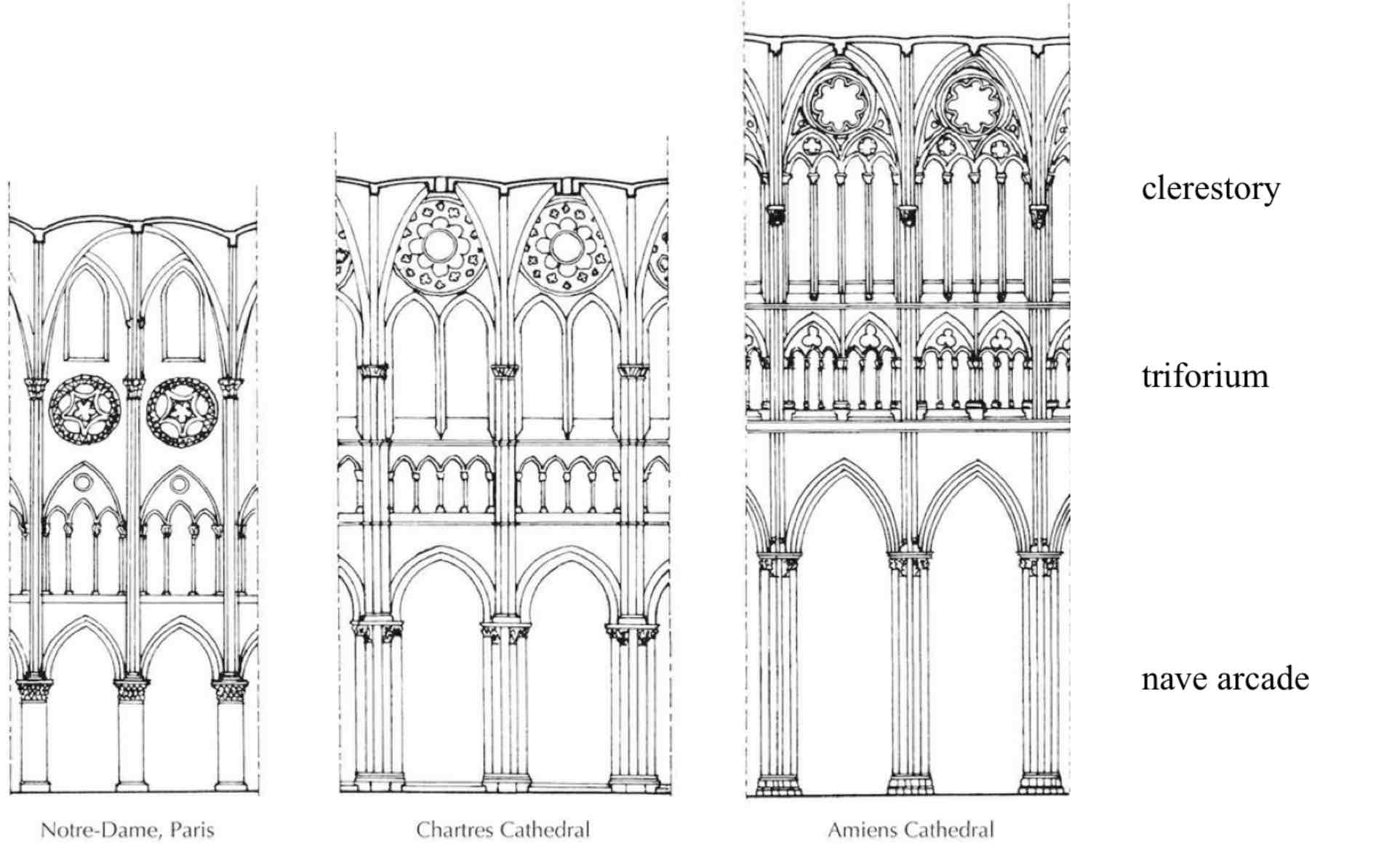
What are the three steps of a Visual(formal) Analysis
Pre-iconographical Description: Basically what do you see when you first look at the art.
Iconography - analysis: Analysis of the visual images and symbols used in the work of art.
Iconology - interpretation: The visual imagery and its symbolism and interpretation, especially in social or political terms.
Facture
The quality of the execution of a painting; an artist’s characteristic handling of the paint.
For example:
Oil on canvas
Watercolor on paper
Ink on Xuan paper
Impasto
A painting technique where a thick layer of paint is laid onto a specific area.
What are the two characteristics of the one-point linear perspective?
Things further away look smaller.
Parallel lines appear to converge in distance to human eyes.
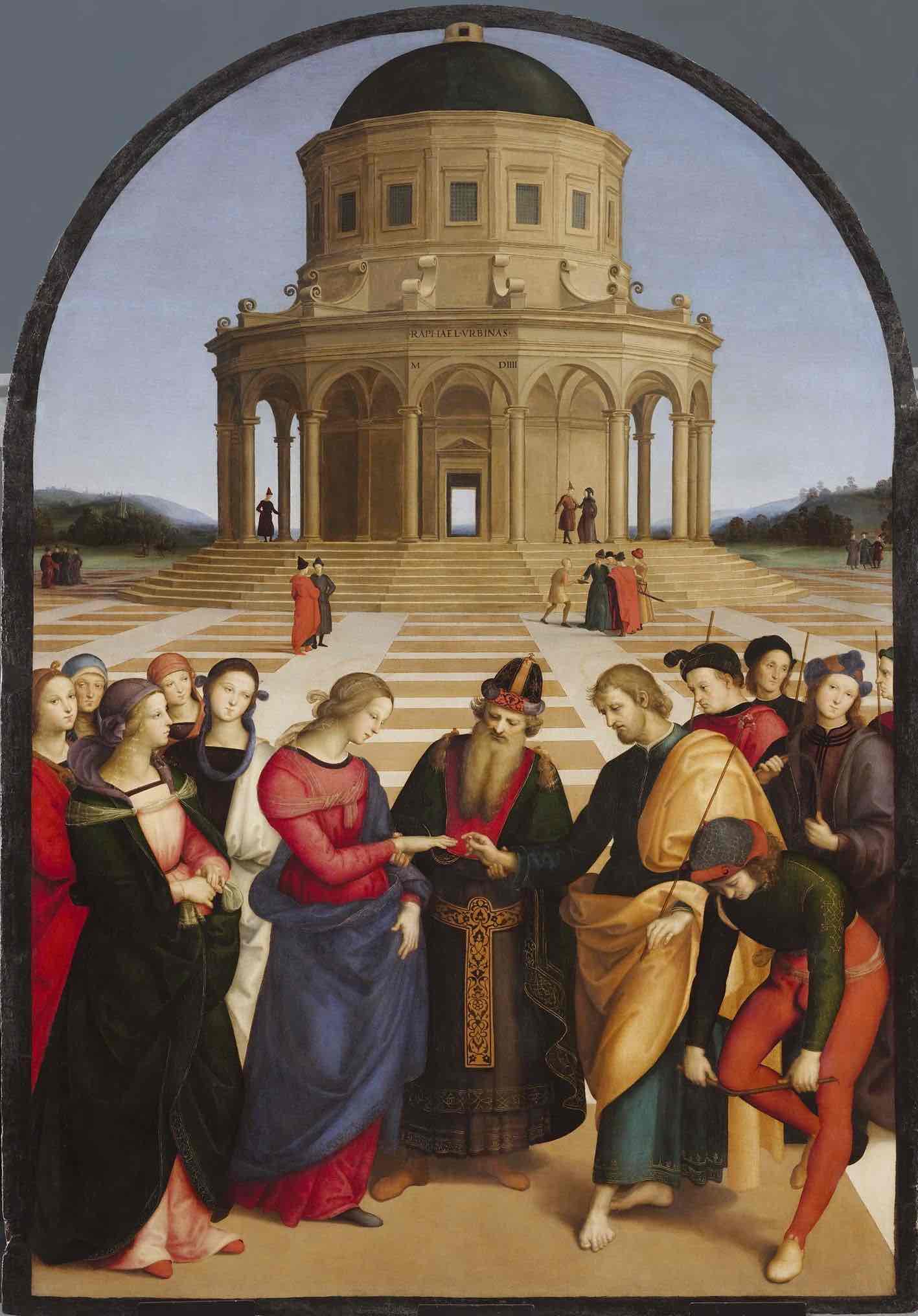
Name of the work: The Marriage of the Virgin
Medium: Oil on roundheaded panel
Subject Matter: Marriage of Virgin Mary to Saint Joseph
Artist: Raphael 🐐
Date: 1504
Art Historical Significance of the work: This painting served as an indicator of the shift towards creating paintings with realistic depth and space. It represents the Christian narrative in the idealized, harmonious aesthetics of the Renaissance.
Relevant Historical/Religious background: Describes an important event in christianity. This painting by Raphael was heavily inspired by his master Perugino’s painting on the same event. Raphael’s painting perfectly balances grace and humanity, the humans are less static and more natural.
Important Compositional characteristics/how it is made: Uses the one point linear perspective. All the women are on the left and the men are on the right. The characters are formed in a semicircle formation. Uses a bright harmonious color pallette. Also a temple takes up most of the space in the painting.

Name of the work: Marble Statue of a Kouros
Medium: Marble duh
Subject Matter: A young male figure in archaic Greek.
Artist: N/A
Date: 590-580 B.C.
Art Historical Significance: One of the earliest stone statues of a human figure. The proportions of the body follow a strict formula that was used by Greek sculptors back then. In this early figure, almost abstract, geometric forms predominate, and anatomical details are rendered schematically.
Relevant Historical/Religious background: Used as a grave marker for a young Athenian aristocrat. These statues are meant to portray the idealized image of youth and physical perfection.
Important Compositional characteristics/how it is made: Uses the subtractive method as it was carved from a single block of marble. The rigid stance, with the left leg forward and arms at the side, was inspired by Egyptian monumental sculpture.

Name of the work: Marble Statue of Eirene
Medium: Marble?????
Subject Matter: The goddess Eirene
Artist: Copy of a Greek bronze statue by Kephisodotos
Date: 14-68 AD, Original was 375/374 and 360/359 B.C
Art Historical Significance: Meant to personify the relationship between peace and prosperity. Reflects the classical greek ideals of beauty, balance, and realism. Piece of art used in expressing social and political beliefs.
Relevant historical/religious background: Most likely erected as part of a public dedication to commemorate the restoration of peace between rival Greek city-states. Peace brings wealth and prosperity to the people.
Important compositional characteristics/how it is made: Uses contrapposto to make Eirene more life-like. Created using the subtractive method.
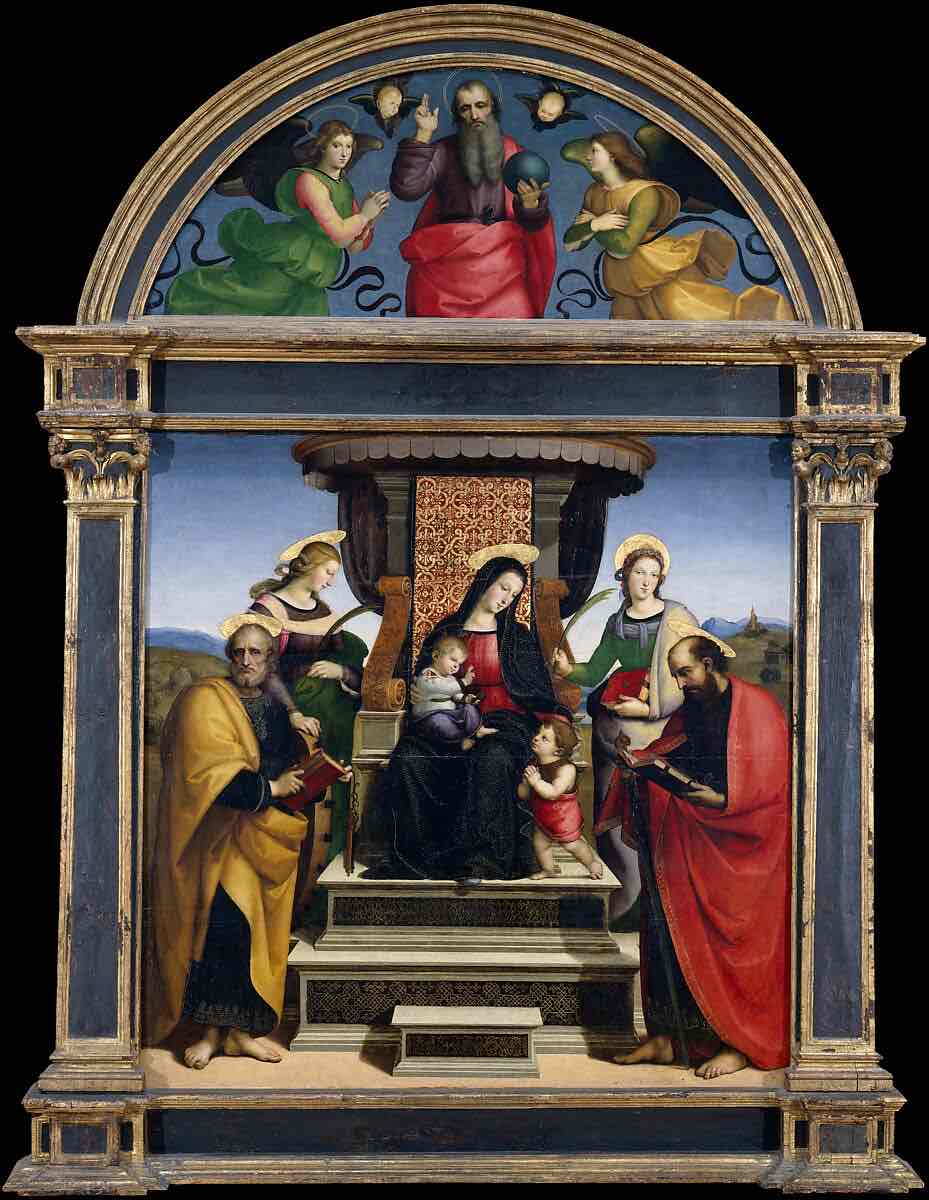
Name of the work: Madonna and Child Enthroned with Saints
Medium: Oil and gold on wood
Subject Matter: Madonna and Jesus 🐐
Artist: Raphael 🐐
Date: 1504
Art historical significance: Painted for the Franciscan Convent of Sant’Antonio in Perugia. Reflect’s the emerging High Renaissance ideals of harmony, naturalism, and classical influence. Serves as an important bridge between the Umbria School of Perugino and the mature works of Raphael in Florence and Rome.
Relevant Historical/Religious Background: Hung in a part of the church reserved for the nuns, which could be why everyone is dressed so conservatively. Depicts a common and significant motif in Christian art. Used as an alter piece. The Catholic Church was the dominant force in commissioning artwork.
Important compositional characteristics/how it is made: The lunette above the main panel depicts God the Father holding a globe and delivering a blessing between two angles and two seraphim’s. The separation of God from the Saints and Mary emphasizes the separation of the divine from the earthly realm. Also Mary is slightly elevated above the saints, demonstrating her importance in relation to them.
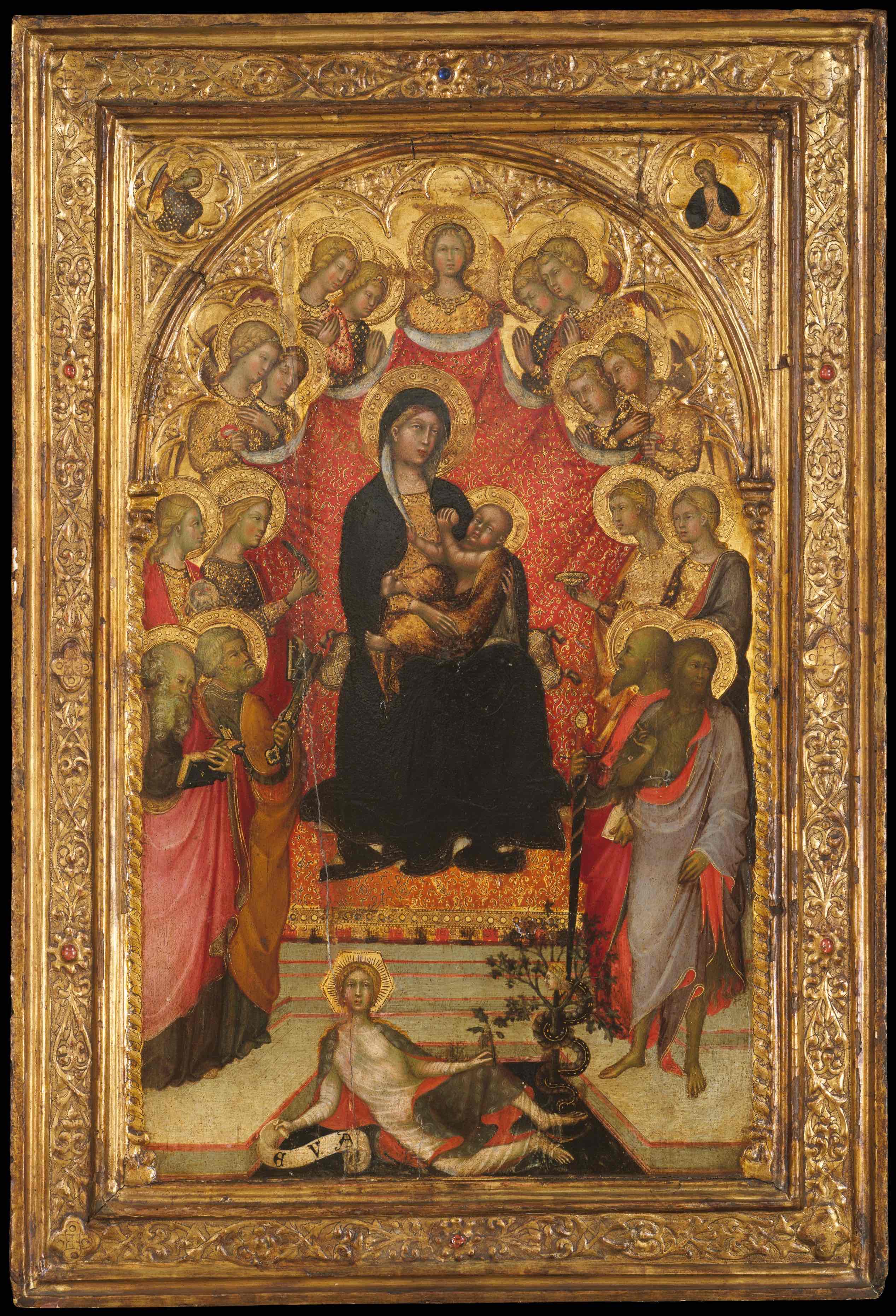
Name of the work: Madonna and Child Enthroned with Saints
Medium: Tempera on Wood, gold ground
Subject Matter: Madonna, Jesus 🐐, and a bunch of Saints
Artist: Paolo di Giovanni Fei(Italian guy)
Date: 1385-1390
Art Historical Significance: The crowdedness of the painting demonstrates the importance of the one point linear system. Created during the transitional phase of the late Gothic Period and the Renaissance. The gold background, intricate detailing, and elongated figures are all hallmarks of the Gothic Style.
Relevant Historical/Religious Background: The painting emphasizes the central role of Madonna and Child in Christianity. Surrounding them are key saints who represent various aspects of Christianity. Also included is Eve and the Serpent who represents Sin in Christianity. Created to be an altarpiece for a church. Note that the halos are perfectly circular except for one.
Important Compositional Characteristics/how it is made: The painting is heavily covered with gold. Madonna and Child sits in the middle surrounded by Saints, emphasizing their importance. Eve and the serpent are at the bottom, personifying the position of sin in christianity(sin = bad). Everyone’s halo is perfectly circular while Eve’s is a hexagon, representing her imperfection.
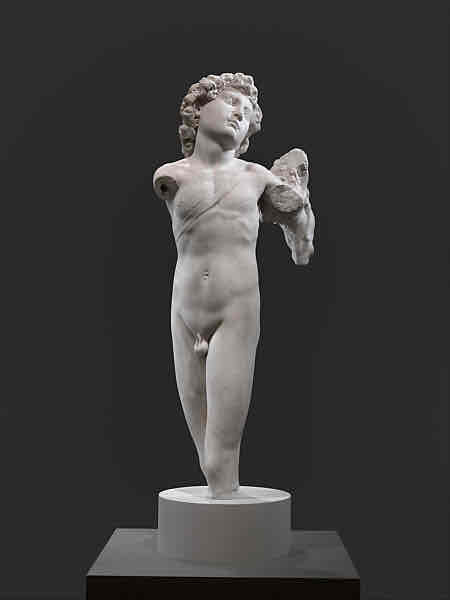
Name of the work: Cupid
Medium: Marble
Subject Matter: Cupid???
Artist: Michelangelo???
Date: 1490
Art historical significance: This statue may or may not be the work of a young Michelangelo. In 1902, it was gravely damaged, which adds a layer of uncertainty to its recognition as a work of Michelangelo.
Relevant Historical/Religious Background: Retitled Cupid in 1650. Stefani Bardini recognized it as Michelangelo’s work at an auction in London, but the attribution was soon forgotten or discounted. Just recently it has been recognized as Michelangelo’s lost Cupid.
Important Compositional Characteristics/how it is made: Like all of Michelangelo’s work, it was created using the subtractive method. However, this statue is missing Cupid’s signature wings. Utilizes contrapposto, the left leg bears all the weight. Young idealized male.
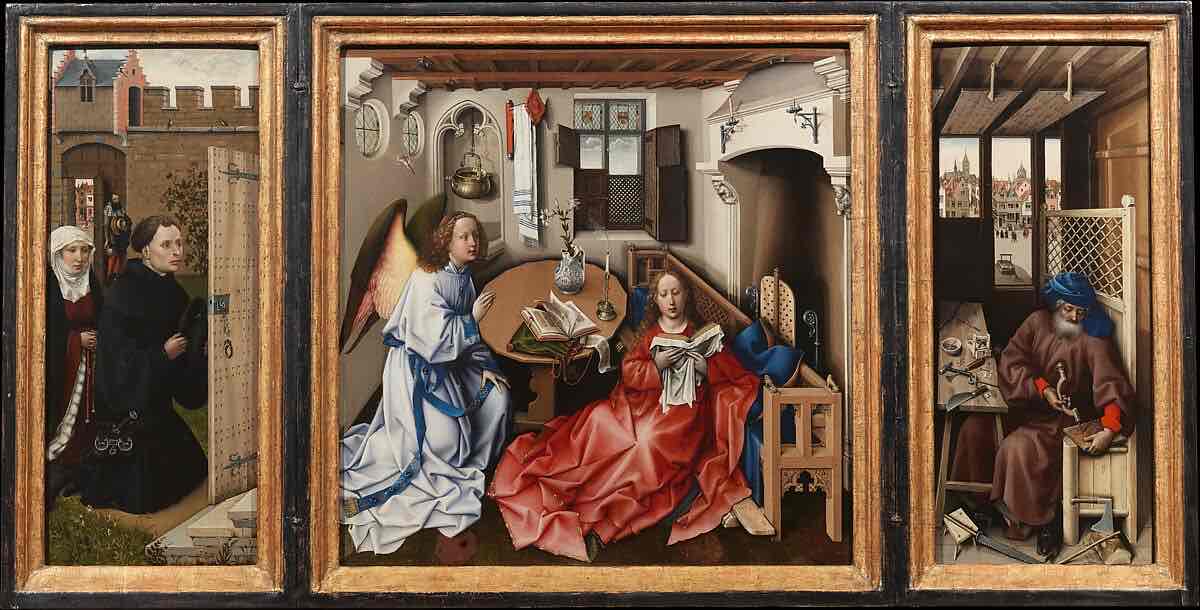
Name: Annunciation Triptych (Merode Alterpiece)
Medium: Oil on Oak
Subject Matter: The angel Gabriel about to tell the Virgin Mary that she will be the mother of Jesus 🐐.
Artist: Workshop of Robert Campin
Date: 1427 - 32
Art Historical Significance: One of the most celebrated early Netherlandish paintings for its detailed observations, rich imagery, and superb condition. Considered a milestone in the transition from medieval to modern painting. Lays the foundation for the development of modern paintings.
Relevant Historical/Religious Background: Created by the Tournai workshop of Robert Campin. He and along with at least two more assistants created this piece. The owner most likely bought it to use in private prayer. On the right is Joseph, betrothed to Mary, working in his workshop. The open bible on the table is meant to convey the Christian Humanist idea that studying the bible for yourself is important.
Important compositional characteristics: Employs the one point linear perspective. The three pieces of the art was made separately. The painting is set in a domestic setting, allowing the viewers to connect with the story. This also ties back to the buyer’s using this painting in private. According to the MET, they bought it to reinforce their hope of having their own kids.
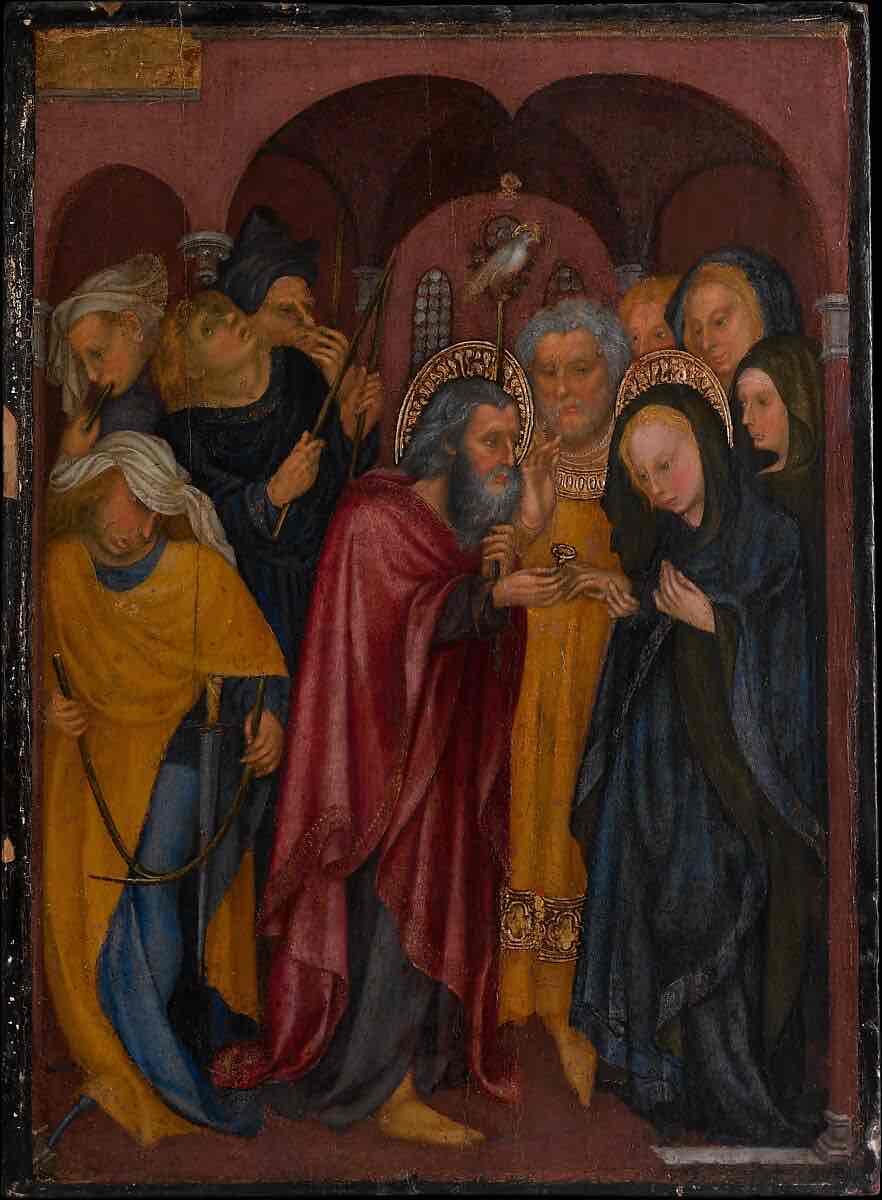
Name: The Marriage of the Virgin
Medium: Tempera and gold on wood
Subject Matter: The Virgin Mary and Saint Joseph
Artist: Michelins de Besozzo
Date: 1430
Art Historical Significance: One of the two panel paintings to be certainly created by Besozzo.
Relevant Historical/Religious Background: According to the Golden Legend, all of the Virgin’s suitors had been obliged to deposit their staffs in the Temple; Joseph’s alone flowered and therefore he was granted the privilege of marrying the Virgin. On his staff is the dove of the holy spirit.
Important Compostional Characteristics/how it is made: All the failed suitors of the Virgin are stood angry/distraught on the left. The dove on Joseph’s staffs signifies gods will. The painting is very cramped, almost as if all the characters are fighting for space. The spacing is inconsistent(look at the columns).
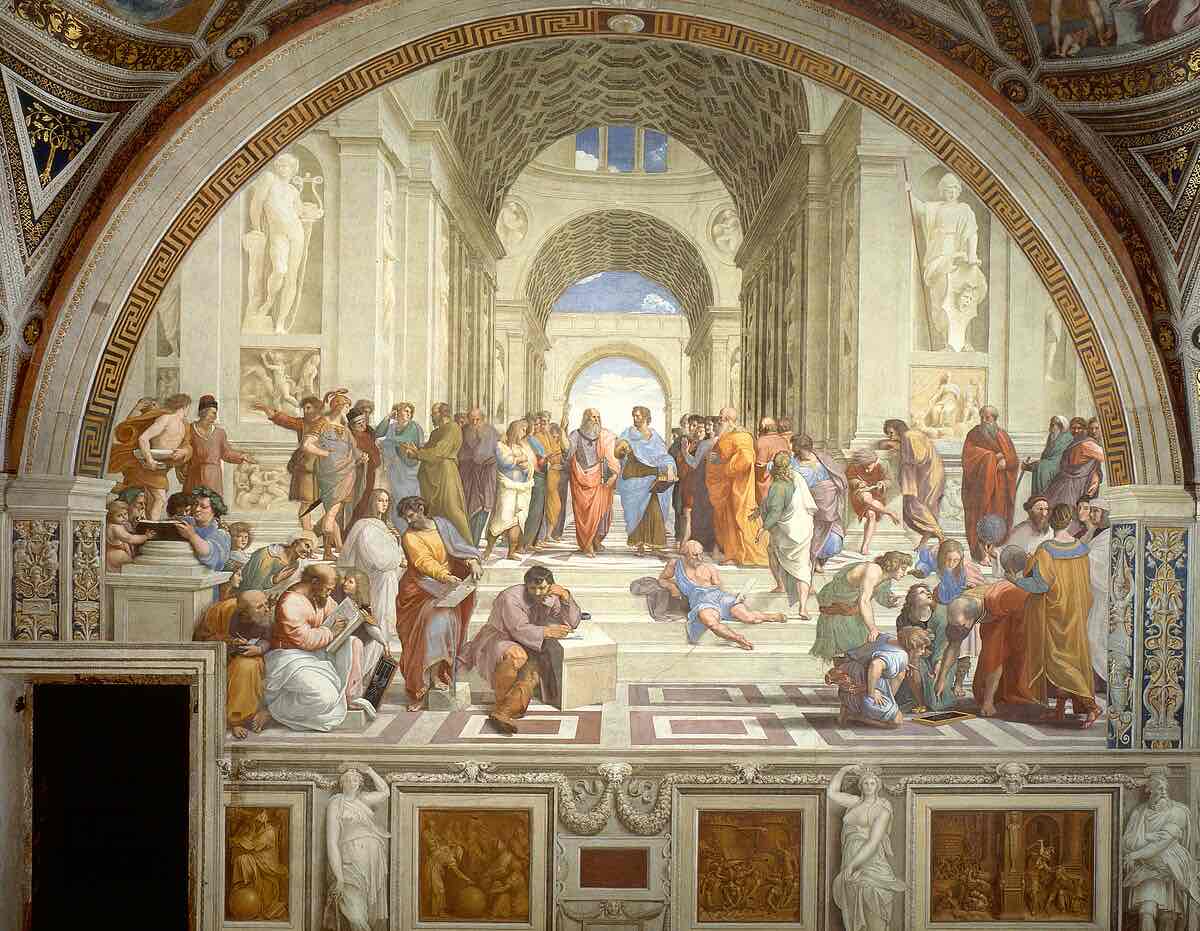
Name: School of Athens
Medium: Fresco
Subject Matter: Bunch of Philosophers
Artist: Raphael my goat
Date: 1509-1511
Art Historical Significance: Perfectly employs the Renaissance techniques of the one point linear perspective and realism to capture the meeting of many great scholars. Represents philosophy as a branch of learning alongside poetry, law, and theology. Commissioned by Pope Julius II to decorate his personal library. Also includes Raphael, showing that his personal view of himself. Complex allegory of secular knowledge, illustrating the historical continuity of Platonic thought.
Relevant Historical/Religious Background: Reflects the Renaissance renewed interest in ancient Greek and Roman Philosophy, art, and culture.
Important composition characteristics/how it is made: The one point linear perspective draws the views attention to the two central figures, Plato and Aristotle. This emphasizes their importance in history. Also the open sky in the background signifies God. Raphael is the only character who looks directly at the viewer.
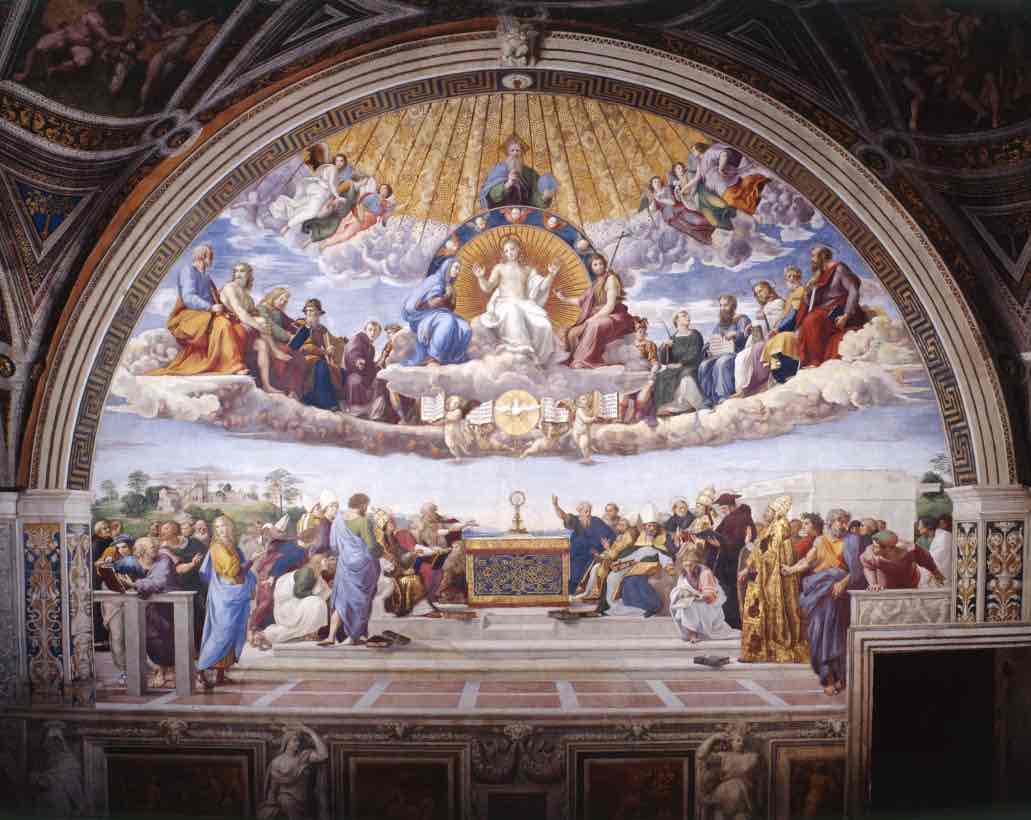
Name: Disputation of the Holy Sacrament
Medium: Fresco
Subject Matter: The name
Artist: Raphael
Date: 1509-1510
Art Historical Significance: Painted during the reign of Pope Julius 2nd. The fresco serves as a reflection of the Catholic Church’s assertion of its spiritual authority. This painting represents theology and faith and is meant to juxtapose the School of Athens.
Relevant Historical/Religious Background: In the middle of the painting sits the Holy Sacrament. The doctrine of transubstantiation- the transformation of the substance of bread and wine into the actual body and blood of christ- was a key tenet of the Catholic faith. It also reflects the High Renaissance interest in balancing human reasoning with faith. This can be seen as humans in the lower level and the heavenly saints are in a dispute over the same subject.
Important Compositional characteristics/how it is made: Everything that is “heavenly” is circular. The Holy Sacrament on Earth, the cloud platform in which the saints sit on, and God’s realm are all circular. Earthly things do not have this same property, showing the distinction between the divine and the mundane. The fresco is divided into three distinct levels, representing the realm of God, the middle acts as a bridge between heaven and earth, and finally at the bottom is the earthly realm. God is at the very top, the saints in the middle, and the theologians and scholars are at the bottom.
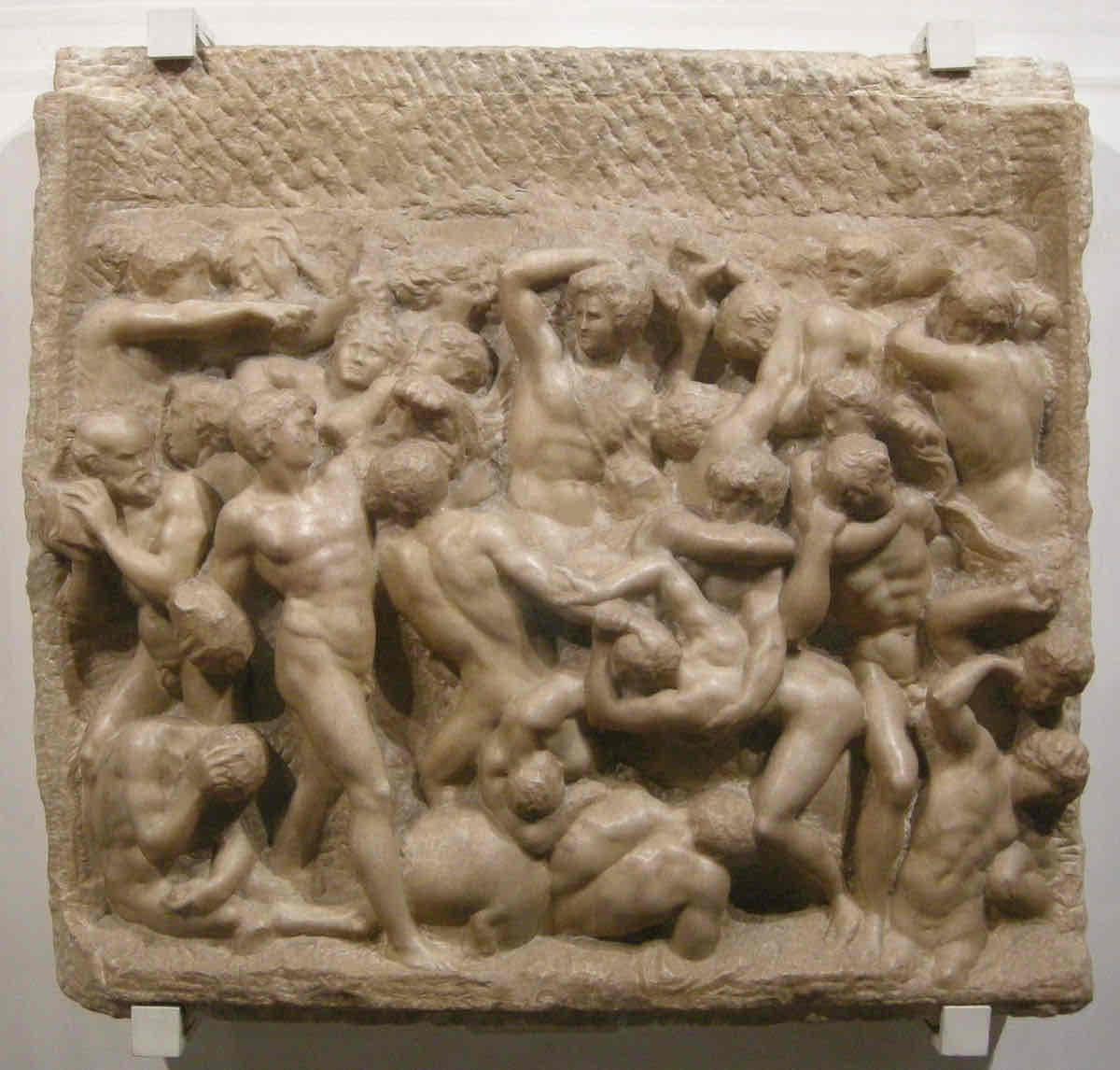
Name: Battle of the Centaurs
Medium: Marble
Subject Matter: The name idk
Artist: Michelangelo
Date: 1490 - 1492
Art Historical Significance: Regarded by Michelangelo himself as one of the best of his early works. An early turning point and a harbinger of Michelangelo’s future. The composition of the figure’s upper limbs deviates from the carefully articulated norms.
Relevant Historical/Religious Background: The sculpture depicts a famous mythic battle in ancient Greece. It was the last work Michelangelo created while under the patronage of Medici.
Important Compositional characteristics/how it is made: The sculpture is unfinished, whether intentional or not is up in the air. It is created using the subtractive method, giving the views the sense that the figures are emerging from the marble.
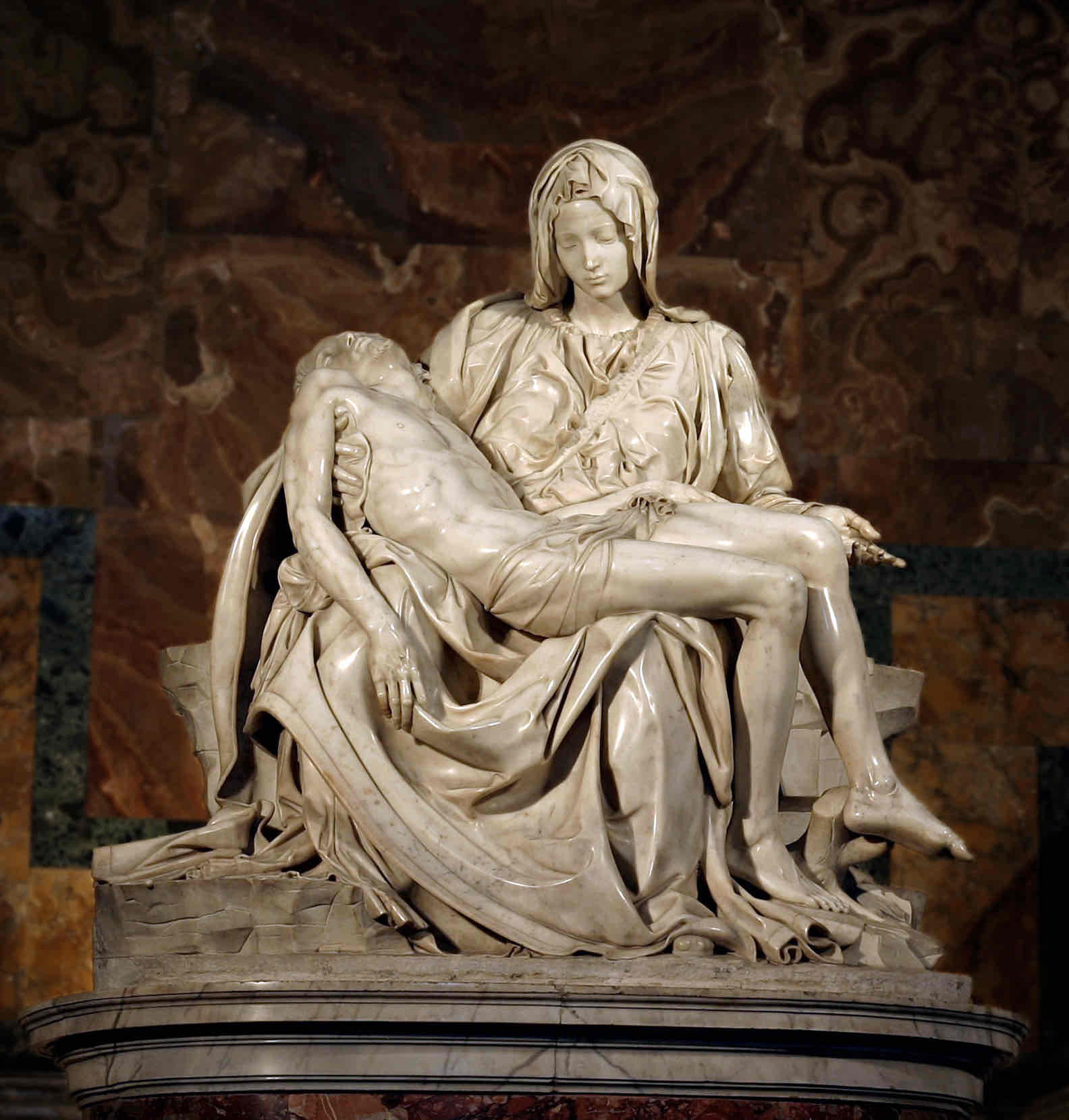
This sculpture is so tuff
Name: Pieta
Medium: Marble
Subject Matter: Mary holding the dead body of Jesus after his crucifixion
Artist: Michelangelo
Date: 1498-1499
Art Historical Significance: The only piece that Michelangelo signed. Balances the renaissance ideals of classical beauty with naturalism. Pyramidal Composition influenced many future works.
Relevant Historical/Religious Background: The pieta is a famous theme in christian art, depicting the Virgin Mary supporting the dead body of Christ. This certain piece was probably made to be an alterpiece for the cardinal’s funeral chapel in Old St. peter’s.
Important Compositional characteristics/how it is made: Subtractive method. The virgin Mary is depicted to be very young. Her face shows very little emotion as if shes accepting god’s will. Uses optical illusions to make the proportions seem natural.
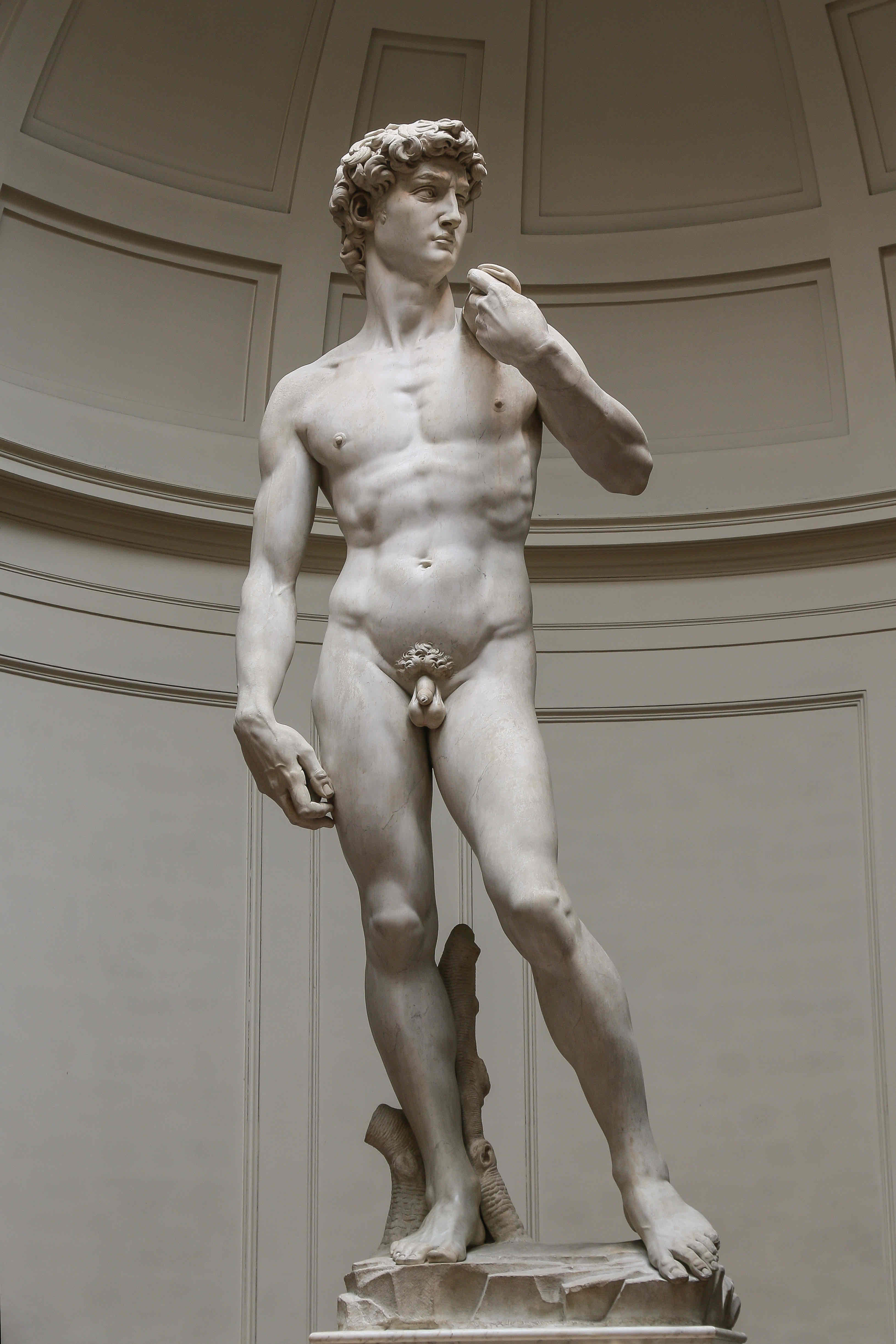
Overrated
Name: David
Medium: Carrara Marble
Subject Matter: Biblical David
Artist: Michelangelo
Date: 1501-1504
Art Historical Significance: Came to symbolize the independence and civil liberties of Florence. Its placement in front of Palazzo Vecchio symbolized the Florentine Republic’s resistance against the Medici family.
Relevant Historical/Religious Background: Made to depict the Biblical David right before his battle with Goliath.
Important Compositional characteristics/how it is made: Subtractive Method. David is entirely nude with the exception of his sling. Michelangelo decided to sculpt david in the moment of high tension(right before facing off against Goliath). This makes it very introspective as much is left to the reader’s imagination.

Name: David
Medium: Marble
Subject Matter: David
Artist: Gian Lorenzo Bernini
Date: 1623-24
Art Historical Significance: Perfectly captures the Baroque style of movement, emotion, and drama. Symbol of the Catholic Church and of the Counter-Reformation.
Relevant Historical/Religious Background: The sculpture depicts David in the moment of success, right before he releases the stone.
Important Compositional characteristics/how it is made: Created using the additive method which allows for the incredible depiction of human movement. Bernini gives everything to the viewer, leaving very little up to the iimagination. It captures the split second of maximum drama.

Name: Apollo and Daphne
Medium: Marble
Subject Matter: The god Apollo and the nymph Daphne
Artist: Gian Lorenzo Bernini
Date: 1622-1625
Art Historical Significance: A masterpiece of Baroque Art. Idk what else to put
Relevant Historical/Religious Background: It portrays the tortuous scene of Apollo chasing after Daphne. Daphne begs for her father to destroy her beauty thus turning her into a tree.
Important Compositional characteristics/how it is made: Created using the additive method. From one side her body is totally visible while on the opposite side her body is entirely bark. There is no emotion on Apollo’s face as he is fully driven by lust while Daphne is scared to death.
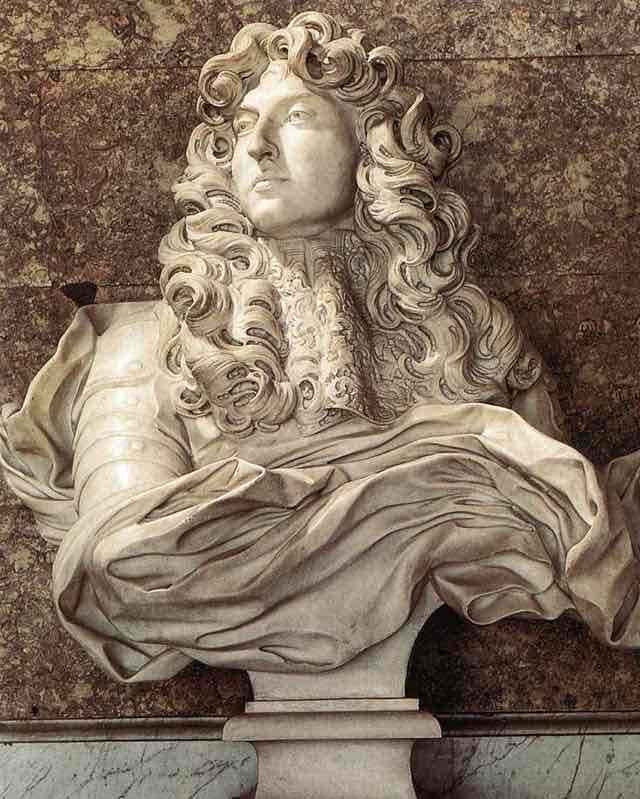
Name: Bust of Louis XIV
Medium: Marble
Subject Matter: Louis XIV
Artist: Bernini
Date: 1665
Art Historical Significance: Landmark piece of Baroque portraiture. Sets a standard for future busts of monarchs with its idealized features and regal presence.
The Relevant Historical background: Created during a larger diplomatic exchange between Papacy and France.
Important compositional characteristics/how it was made: Louis XIV is seen looking up and wearing a suit of armor even though he was never a military leader. This adds to the grandeur and makes the image of the King so much more intimidating. The Clothes also seem to be flowing with the wind adding a dramatic element.
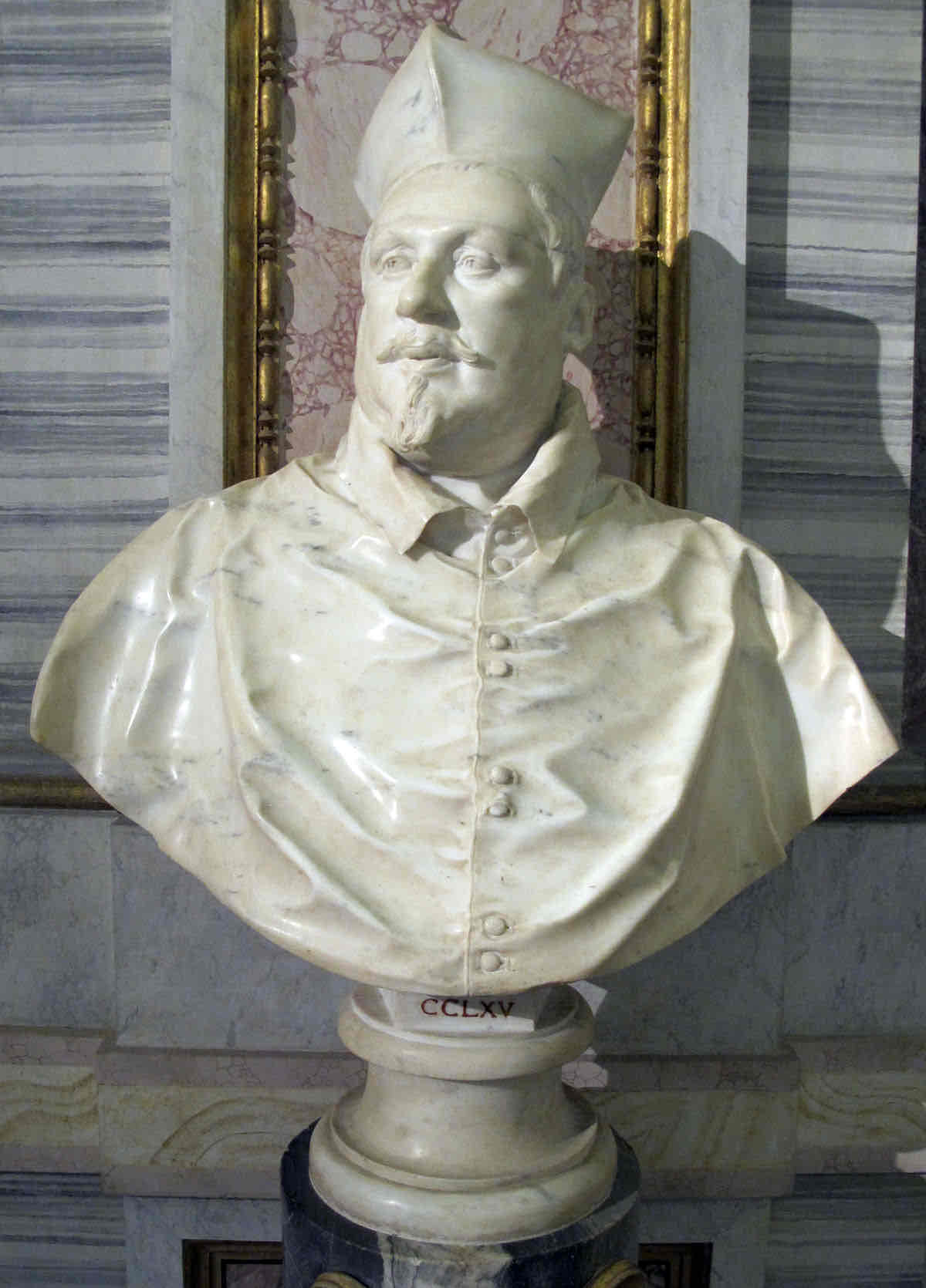
Name: Bust of Scipione Borghese
Medium: Marble
Subject Matter: Scipione Borghese
Artist: Bernini
Date: 1632
Art Historical Significance: The bust was created in record time, over the course of 15 nights. Indicated a turning point in Bernini’s style in portraiture. He introduced the motif of the interrupted conversation.
Relevant Historical/Religious Background: This bust was created last minute to replace one had broken right before it was meant to be presented. Compared to the original one, this bust has less wrinkles, hides the patron’s fat neck, and makes him seem more confident.
Important Compositional characteristics/how it is made: Presents the subject in a passing moment rather than a pose to create more naturalism. Created using the subtractive method.
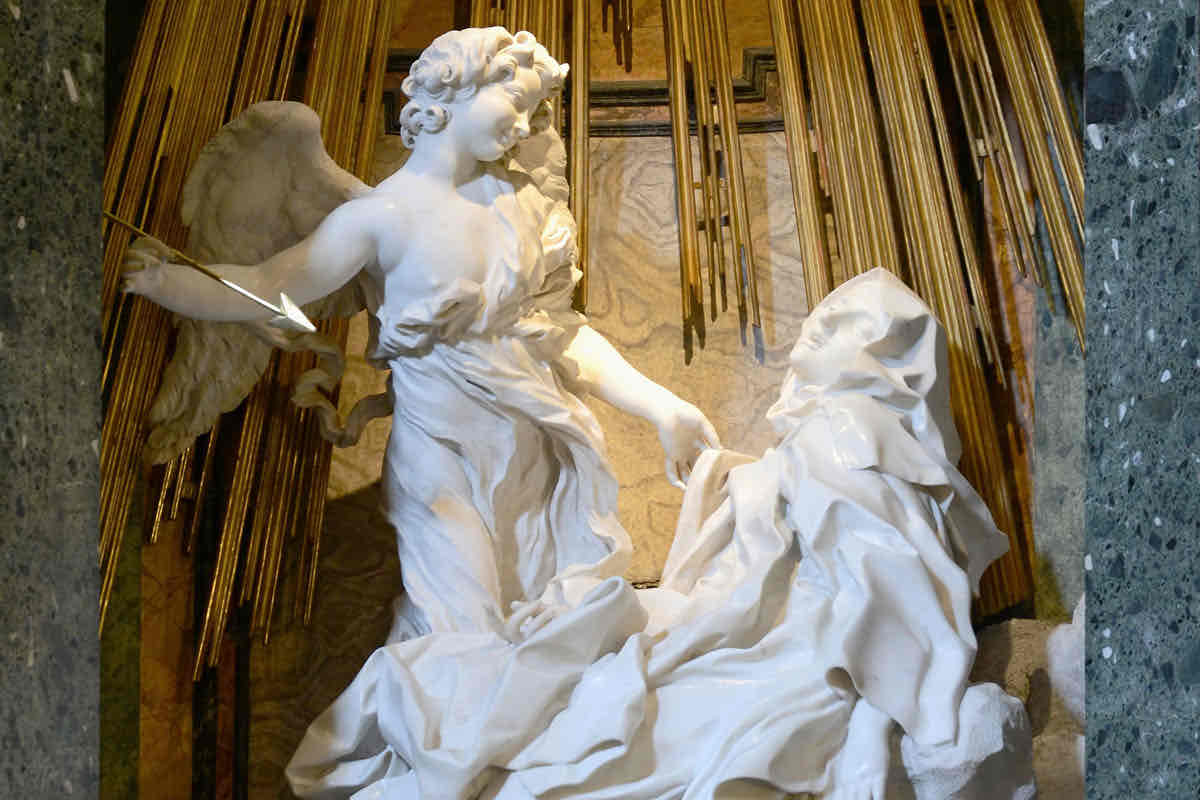
Name: Ecstasy of Saint Teresa
Medium: Marble
Subject Matter: In the name
Artist: Gian Lorenzo Bernini
Date: 1647-1652
Art Historical Significance: Attempts to depict an emotional and mystical experience. Transverberation.
Relevant Historical/Religious Background: Based on Saint Teresa’s own written account of her vision of an angel piercing her heart with a fiery arrow, representing the pain and pleasure of divine love.
Important compositional characteristics: Uses the additive method. Includes only saint teresa and one angel, creating a sense of intimacy. They are also floating on a cloud.
Iconoclasm
The deliberate destruction of religious images, symbols, or monuments for political or religious reasons.
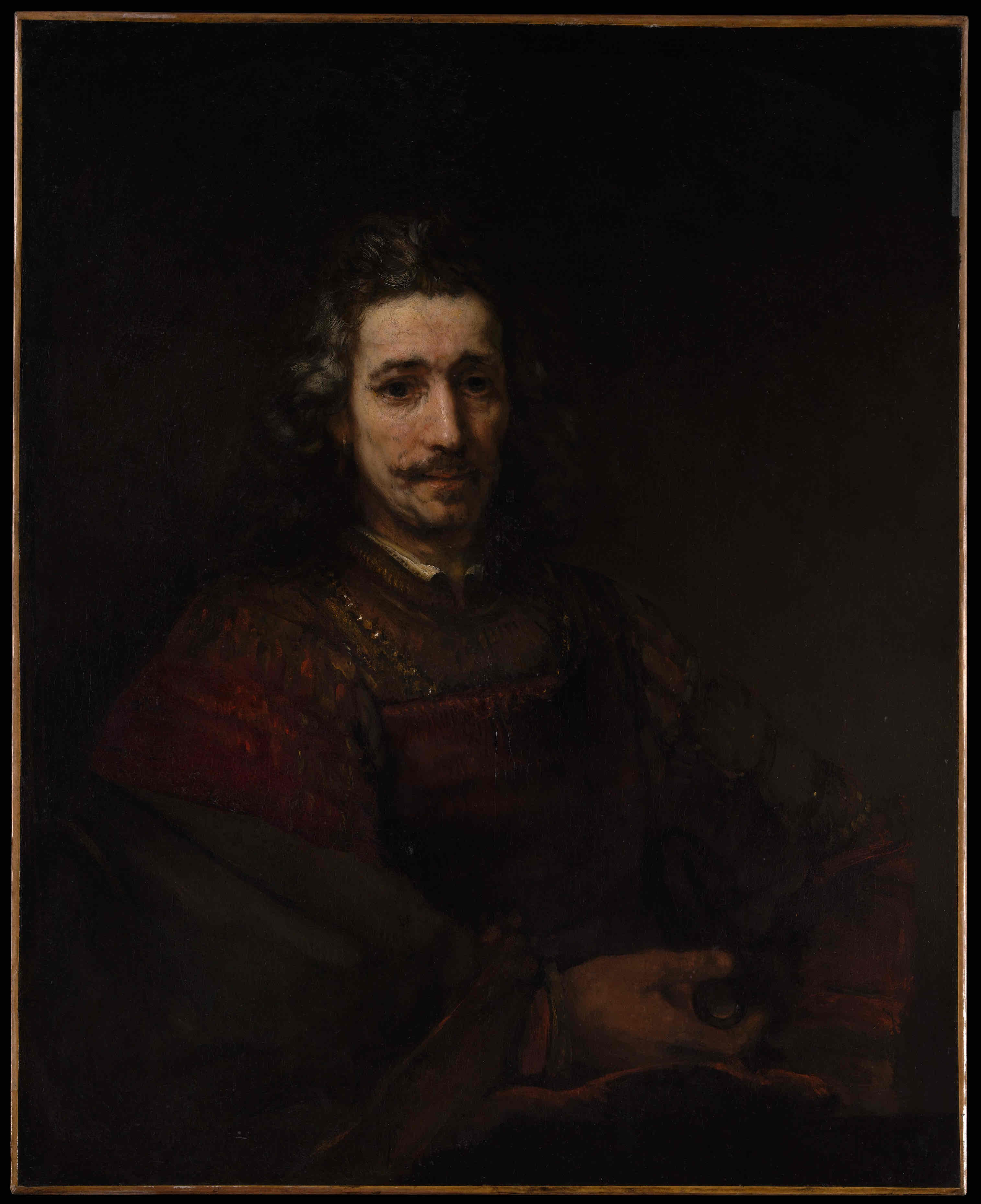
Name: Man with a Magnifying Glass
Medium: Oil on Canvas
Subject Matter: N/A
Artist: Rembrandt
Date: Early 1660s
Art Historical Significance: Indicative of the Baroque and Tenebrism art movements.
Relevant Historical/Religious Background: Depicts, finally, not a patron of the Church but rather someone belonging to the middle class.
Important Compositional Characteristics/how it is made: Rembrandt’s manipulation of light is masterful. The face is the mainly lit section of the painting, drawing the focus of the view towards it. Makes it more natural.

Name: Lucretia
Medium: Oil on Canvas
Subject Matter: Lucretia 🐐
Artist: Rembrandt
Date: 1666
Art Historical Significance: Exemplifies Baroque realism through the detailed textures of clothing and somber depiction of Lucretia.
Relevant Historical/Religious Background: Lucretia was a noblewomen in ancient Rome who was raped and as a result killed herself to preserve her honor. This sparked a rebellion leading to the establishment of the Roman Republic.
Important Compositional Characteristics/how it is made: Rembrandt reduces distractions and puts the focus on Lucretia’s expressive face and body language. This gives insight into her inner struggles and emphasizes her emotional turmoil.
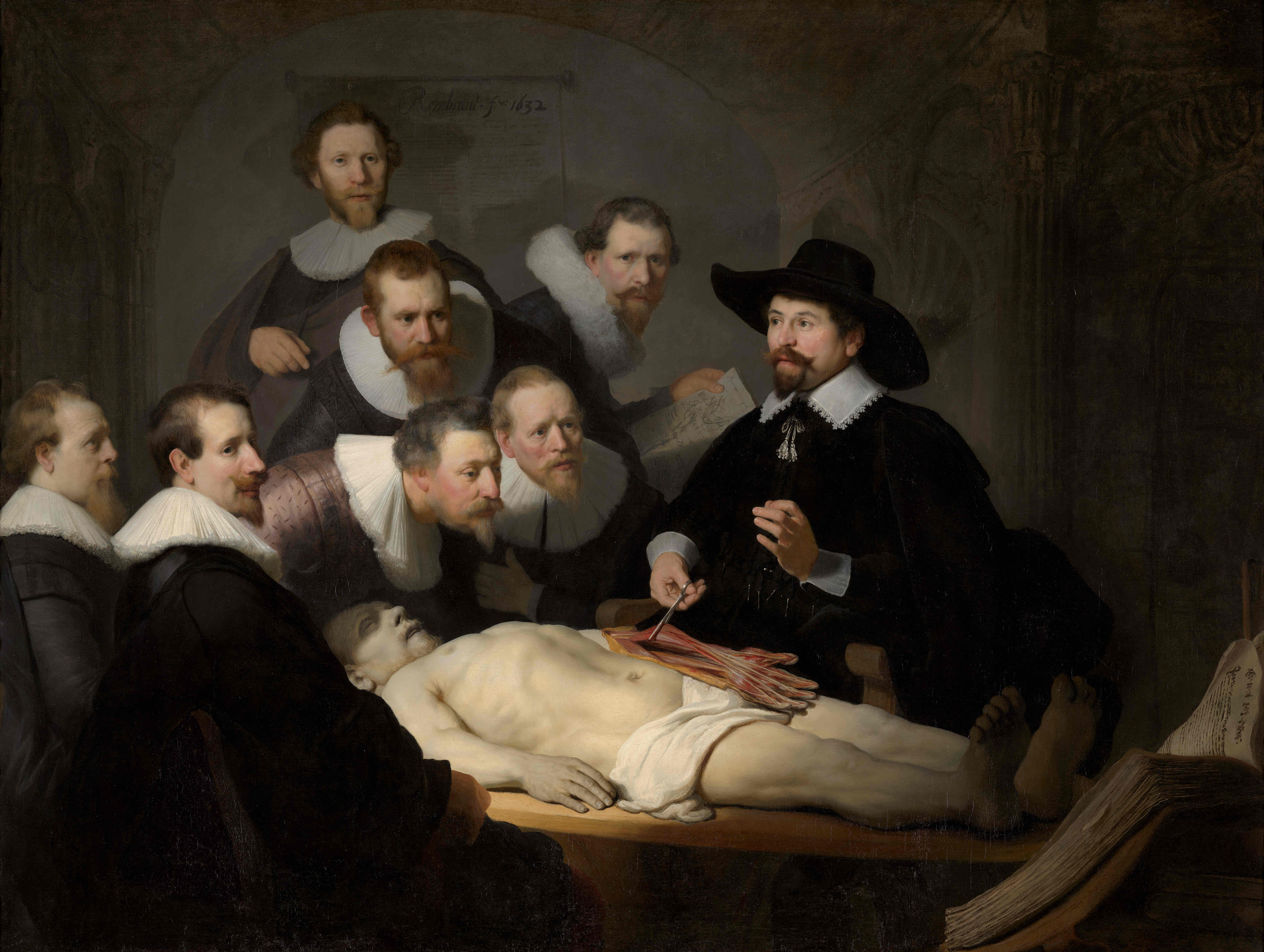
Name: The Anatomy of Dr. Tulp
Medium: Oil on Canvas
Subject Matter: Nicolaes Tulp
Artist: Rembrandt
Date: 1632
Art Historical Significance: Baroque Painting, Dutch Golden Age Painting
Relevant Historical/Religious Background: Anatomy lessons were a social event in the 17th century taken place in lecture rooms. An important scientist like Tulp would not cut and dissect, instead they taught.
Important Compositional Characteristics/how it is made: The book at the lower right corner helps set the perspective of the viewer. By making the characters look engaged in the moment, it creates a sense of realism. The dark background also puts the spotlight on the anatomy lessons.
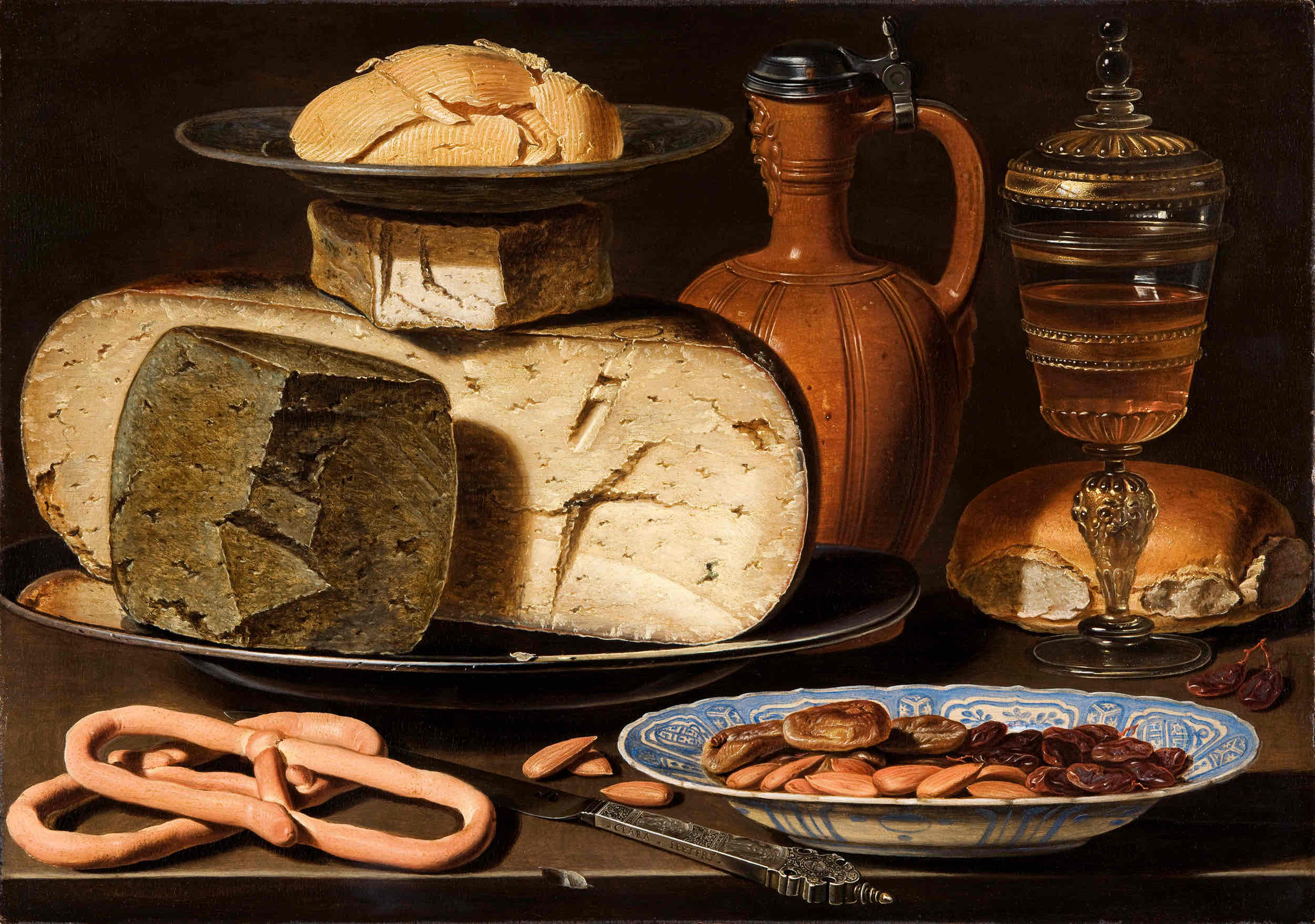
Name: Still Life with Cheeses, Almonds, and Pretzels
Medium: Oil on panel
Subject Matter: Food
Artist: Clara Peeters
Date: 1615
Art Historical Significance: Exemplifies the Dutch Golden Age still life genre. Also saw the emergence of female artist, particularly in this genre.
Relevant Historical/Religious Background: With the rise of economic activity generated by the East India Company, many people were starting to live better lives. The painting represents the danger of excess consumption caused by this. better food = more rich
Important Compositional Characteristics: Includes many reflections of herself. Captures a wide range of textures enhancing the realism of the compositions.
Chiaroscuro
An artistic method using gradations of light and shadow to create convincing three-dimensional scenes. Halftone
The 2 categories of printing
Relief
Intaglio
Engraving vs. Etching
Engraving: Artists manually carve lines into a metal plate using a sharp took called burin.
Produces clean, precise lines
Known for its fine detail and sharpness
Lasts longer
Etching: Covers a metal plate with a protective wax coating or ground. The artist then draws through the wax using a needle, exposing the metal beneath. Then it is places in an acid bath that eats into the exposed metal.
Results in a more fluid and freehand style. The needle can move more easily through the wax.

Name: Cardinal Scipione Borghese
Medium: Marble
Artist: Giuliano Finelli
Subject Matter: In the same
Date: 1631-1632
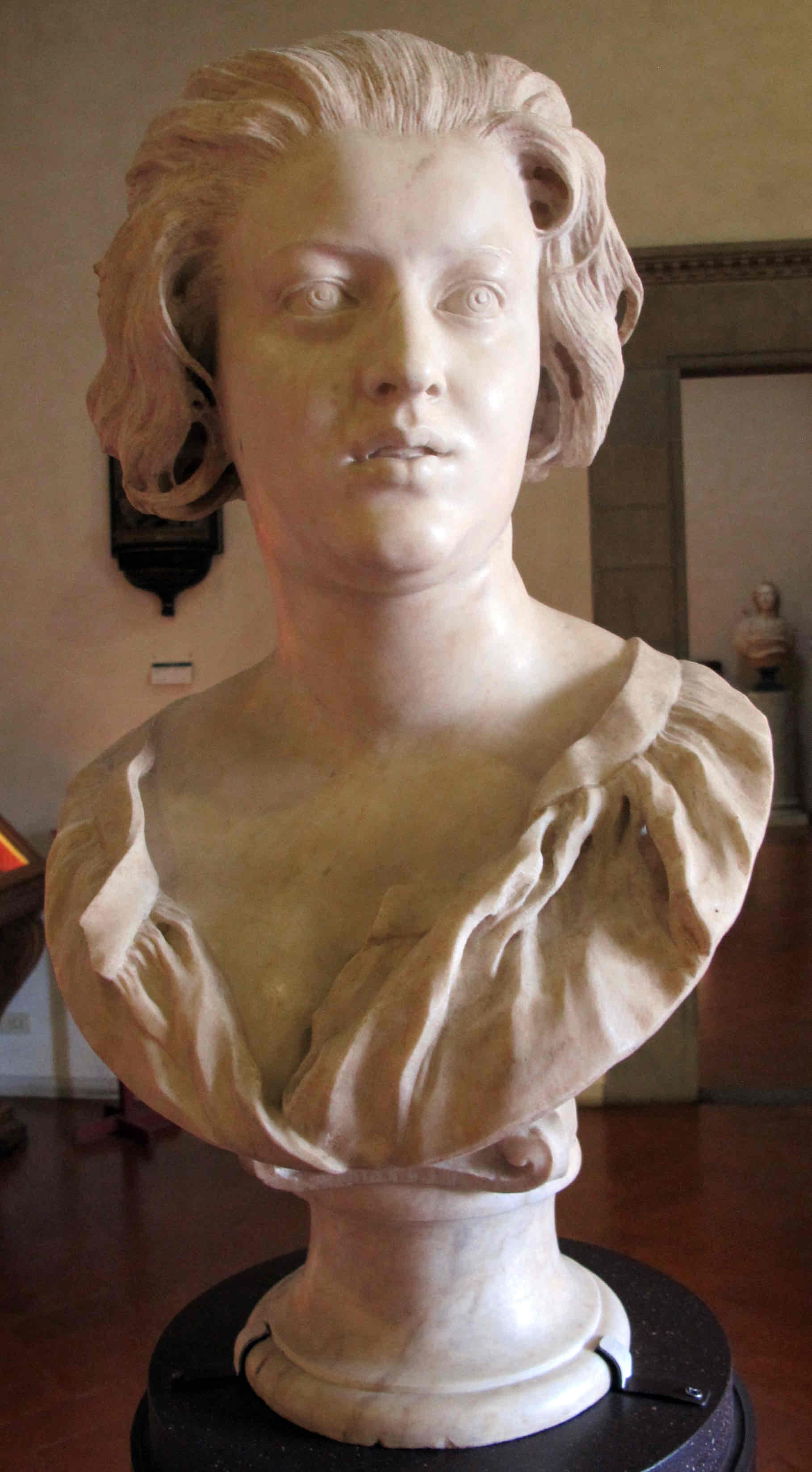
Name: Portrait of Constanza Bonarelli
Medium: Marble
Artist: Bernini
Subject Matter: Constanza Bonarelli
Date: 1631